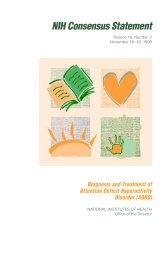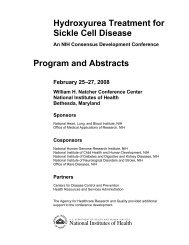Celiac Disease - NIH Consensus Development Program - National ...
Celiac Disease - NIH Consensus Development Program - National ...
Celiac Disease - NIH Consensus Development Program - National ...
You also want an ePaper? Increase the reach of your titles
YUMPU automatically turns print PDFs into web optimized ePapers that Google loves.
How To Provide Effective Education and Resources: Gluten-Free Diets Shelley Case, R.D.A strict gluten-free diet (GFD) for life is the only treatment for celiac disease (CD).Successful management of CD requires (1) a team approach, including the person with CD,family, physicians, a registered dietitian, a celiac support group, and caregivers; (2) anindividualized approach; (3) an understanding of quality-of-life issues; (4) use of evidencebased,current information and resources; and (5) regular followup to monitor compliance andnutritional status, as well as additional information and support. (3,16)Once a diagnosis is made, the physician must clearly communicate, with a positive andoptimistic attitude, an overview of CD and strongly emphasize the importance of a GFD forlife. (16) It is essential that the physician initiate an immediate referral to a registered dietitian withexpertise in CD for nutritional assessment, diet education, meal planning, and assistance with thesocial and emotional adaptation to the new gluten-free lifestyle. (2,7,15,16) A delay in referral, or noreferral at all, increases the likelihood of the patient obtaining inaccurate information from theInternet, health food stores, alternative health practitioners, family, friends, and other sources,often resulting in confusion and frustration. The physician and dietitian should also encouragethe patient to join a local and/or national celiac group for ongoing support, as patients who areactive members are usually more knowledgeable and compliant with their diet. (16) The registereddietitian is the most qualified health care professional to provide medical nutrition therapy(MNT). Table 1 presents a summary of the nutritional assessment, education, and followup ofnewly diagnosed individuals with CD.Gluten-Free Diet and Quality of LifeDietary change requires modification of lifelong eating habits and adoption of new foodhabits. This can be a challenge for most patients with CD, as wheat and wheat-based products aremajor staples in the North American diet. Hectic lifestyles have resulted in more meals eatenaway from home and reliance on prepackaged convenience foods. In addition, the cost of GFspecialty foods is significantly higher than that of gluten-containing foods, and obtaining thesespecialty foods is difficult for some patients.Many studies have investigated the impact of CD and following a GFD on the quality oflife in adults (4,6,8–10) and children (11,17) with varying results. In addition, several studies have lookedat specific lifestyle issues and their effect on the patient’s ability to follow the GFD inadults (5,8,12,14) and children with CD. (18) A significant number of adults with CD report difficultiesfollowing the GFD, especially when eating out in restaurants, at social functions, and whiletraveling. Determining the GF status of foods, finding GF foods, and planning and cooking GFmeals also interfere with their family life and career. Children often feel left out of activities atschool or friends’ homes, are embarrassed to bring GF foods to parties, and are angry abouthaving to follow a special diet.97







